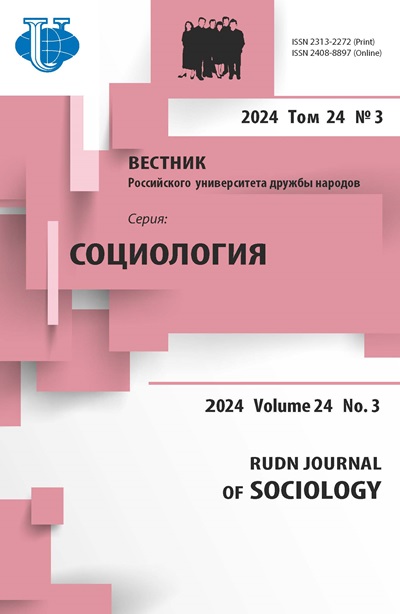Рынок труда в Великобритании в цифровую эпоху: гендерное измерение
- Авторы: Мосакова Е.А.1, Кизилова К.2
-
Учреждения:
- Московский государственный университет им. М.В. Ломоносова
- Институт сравнительных исследований общественного мнения «Евразийский барометр»
- Выпуск: Том 21, № 3 (2021)
- Страницы: 512-519
- Раздел: Современное общество: актуальные проблемы и перспективы развития
- URL: https://journals.rudn.ru/sociology/article/view/27416
- DOI: https://doi.org/10.22363/2313-2272-2021-21-3-512-519
Цитировать
Полный текст
Аннотация
Авторы рассматривают проблему гендерной дискриминации в сфере трудовых отношений в Великобритании в доковидную эпоху. За прошедшие десятилетия западноевропейские страны достигли наиболее значительного за столетие прогресса в обеспечении принципов гендерного равенства в самых разных сферах жизнедеятельности общества, включая трудовые отношения, и стали мировыми лидерами в этой области. Однако, несмотря на все усилия международного сообщества, ни одна страна мира все еще не смогла добиться полного гендерного равенства, и Великобритания не исключение. Авторы считают, что антидискриминационное законодательство Великобритании (разработанное до того, как страна вышла из состава Европейского Союза) основано на международных законодательных актах и конвенциях. В течение длительного времени в Великобритании действовали собственные законы, запрещающие дискриминацию на рынке труда, которые были серьезным препятствием для разработки и внедрения эффективных мер антидискриминационной политики в сфере трудовых отношений. Лишь в 2010 году в Великобритании был принят закон о равенстве, заменивший собой все прежние законодательные правила и содержавший исчерпывающий перечень критериев для определения и запрета дискриминационных практик. В результате Великобритания начала внедрять в сфере трудовых отношений достаточно жесткое антидискриминационное законодательство, что позволило ей в последние несколько десятилетий продвигаться в направлении гендерного равенства в экономике с большей скоростью, чем в среднем характерна для стран Европейского Союза. Исследования подтверждают постепенное сокращение гендерного разрыва в уровне зарплат в Великобритании в последние два десятилетия, что можно считать главным достижением страны в борьбе против гендерной дискриминации на рынке труда. Однако целый ряд проблем сохраняется: относительно низкий уровень представленности женщин на рынке труда, гендерный разрыв в уровне зарплат и доходов, горизонтальная и вертикальная сегрегация, гендерный разрыв в послевузовском образовании и во времени, затрачиваемом на выполнение семейных обязанностей. Возрастная дискриминация - еще одна проблема в сфере трудовых отношений. В Европейском Союзе первые законы, запрещающие возрастную дискриминацию, были приняты только в 2000-е годы, в Великобритании - в 2006 году. Возрастная дискриминация остается актуальной проблемой для рынка труда Великобритании, поскольку возраст - третий по значимости дискриминационный фактор после пола и ограниченных возможностей.
Об авторах
Елизавета Александровна Мосакова
Московский государственный университет им. М.В. Ломоносова
Автор, ответственный за переписку.
Email: lizavetam@mail.ru
кандидат экономических наук, доцент кафедры ЮНЕСКО по изучению глобальных проблем факультета глобальных процессов
Ленинские горы, 1, стр. 13а, Москва, Россия 119991Ксения Кизилова
Институт сравнительных исследований общественного мнения «Евразийский барометр»
Email: ksenniya.kizilova@gmail.com
заместитель директора Института сравнительных исследований общественного мнения «Евразийский барометр» (Вена, Австрия); руководитель секретариата Исследовательской ассоциации «Мировые ценности» (Стокгольм, Швеция); генеральный секретарь Исследовательского комитета «Сравнительное общественное мнение» Международной политологической ассоциации (Монреаль, Канада)
Панингассе 17/7, Вена, 1040, АвстрияСписок литературы
- Bratt C., Abrams D., Swift H. J., Vauclair C. M., Marques S. Perceived age discrimination across age in Europe: From an ageing society to a society for all ages. Development Psychology. 2018; 54 (1).
- Convention Concerning Discrimination in Respect of Employment and Occupation 1958/ URL: https://www.un.org/en/development/desa/population/migration/generalassembly/docs/ global compact/ ILO_C_111.pdf.
- Equality Act 2010. URL: http://www.legis lation.gov.uk/ukpga/2010/15/section/17.
- Gender Equality Report 2020. URL: https://ec.europa.eu/info/policies/justice-and-fundamental-rights/gender-equality_en.
- Gender mainstreaming for health managers: A practical approach. 2011. URL: https://www.who.int/gender-equity-rights/knowledge/health_ manage rs_guide/en.
- Gender wage gap, EU, 2019 // https://data.oecd.org/earnwage/gender-wage-gap.htm.
- Hardy S., Butler M. European Employment Laws: A Comparative Guide. Ongar; 2011.
- Sex Discrimination Act 1975. URL: http://www.legislation.gov.uk/ukpga/1975/65/contents.
- Sustainable Development in the European Union. Monitoring Report on Progress towards the SDGs in the EU Context. Luxembourg; 2019.
- Global Competitiveness Report 2020. URL. https://reports.weforum.org/global-gender-gap-report-2020.
- Transforming our World: 2030 Agenda for Sustainable Development. URL: https://sdgs.un.org/ publications/transforming-our-world-2030-agenda-sustainable-development-17981.
- United Nations Charter // https://www.un.org/en/about-us/un-charter.
- Bazarov B.N. Legal regulation of discrimination in the field of labor law on the example of the European Union and Great Britain. Tribune of Scientists. 2020; 2. (In Russ.).
- Bezsonov V.O. Legal regulation of the prohibition of discrimination in the UK. Epomen. 2020; 44. (In Russ.).
- Govorova N.V. The European Union market in the digital age: Gender. Woman in Russian Society. 2020; 3. (In Russ.).
- Zajkov D.E. The principle of equal rights and freedoms for men and women: Current state and prospects. Law Journal of the HSE. 2020; 4. (In Russ.).
- Ivanova M.А. Demand for older workers and age discrimination: International experience and Russian realities. Voprosy Ekonomiki. 2019; 6. (In Russ.).
- Mosakova E.А. Gender discrimination in the labor market of Russia and Japan. Information Society. 2017; 6. (In Russ.).
- Nikolaev I.А., Marchenko T.E., Tochilkina O.S. Gender wage gap. Society and Economy. 2018; 2. (In Russ.).














